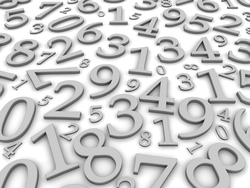3- digit Mania
 There are four 3-digit natural numbers, each of them equals the sum of the cubes of its digits.
There are four 3-digit natural numbers, each of them equals the sum of the cubes of its digits.
Three of them are:
153=1+125+27
370=27+343+0
407=64+0+343
Do you know what the fourth one is? It does not begin with 0, otherwise it isn't a 3-digit number.
Hint --- Its not as difficult as it appears. Look at the 3 numbers given.
The answer is 371.
This section requires Javascript.
You are seeing this because something didn't load right. We suggest you, (a) try
refreshing the page, (b) enabling javascript if it is disabled on your browser and,
finally, (c)
loading the
non-javascript version of this page
. We're sorry about the hassle.
3 solutions
It's actually Malaysian National Maths Olympiad Competition if translated in English...
ok, but I failed to solve this, I knew the answer when I overheard two people discussing
after 11,actually 12^3= 1728 216+512+1000=1728
How would someone figure that out?
Can you show that there are no others?
Log in to reply
Dear Calvin, You are correct. I posted these numbers called Narcissistic numbers as an oddity.
An n-digit number that is the sum of the nth powers of its digits is called an n-narcissistic number. It is also sometimes known as an Armstrong number, perfect digital invariant (Madachy 1979), or plus perfect number.
Hardy (1993) wrote, "There are just four numbers, after unity, which are the sums of the cubes of their digits: 153=1^3+5^3+3^3, 370=3^3+7^3+0^3, 371=3^3+7^3+1^3, and 407=4^3+0^3+7^3.
The smallest example of a narcissistic number other than the trivial 1-digit numbers is 153=1^3+5^3+3^3.
The first few are given by 1, 2, 3, 4, 5, 6, 7, 8, 9, 153, 370, 371, 407, 1634, 8208, 9474, 54748, ...
It can easily be shown that base-10 n-narcissistic numbers can exist only for n<=60, since n·9^n<10^(n-1) for n>60.
In fact, a total of 88 narcissistic numbers exist in base 10, as proved by D. Winter in 1985 and verified by D. Hoey. T. A. Mendes Oliveira e Silva gave the full sequence in a posting to sci.math on May 9, 1994.
As a matter of fact Hardy (1993) wrote, "There are just four numbers, after unity, which are the sums of the cubes of their digits: 153=1^3+5^3+3^3, 370=3^3+7^3+0^3, 371=3^3+7^3+1^3, and 407=4^3+0^3+7^3. These are odd facts, very suitable for puzzle columns and likely to amuse amateurs, but there is nothing in them which appeals to the mathematician."
If you agree with the above statement, my apologies for posting this oddity. Please delete the problem. :) Regards Satyen
Log in to reply
There is nothing wrong with this problem. I was wondering what the approach was, and to see if the question should be classified under number theory (find an argument), or computer science (test all the 3-digit numbers).
Thanks for sharing the historic reference.
Log in to reply
@Calvin Lin – HEY CALVIN SIR. THE APPROACH IS SIMPLE. ONE HINT GIVEN IN THE QUESTION SAYS IT ALL. LOOK AT THE NUMBERS GIVEN. 370 IS ONE OF THE NUMBERS AND IF WE INTERCHANGE 0 WITH ONE THERE WILL BE A CHANGE OF +1 TO THE NUMBER AND THE CUBE OF 1 IS ALSO ONE SO WE ARE ADDING ONE TO THE NUMBER AND THE NUMBER BECOMES 1 MORE THAN THE PREVIOUS NUMBER IT SATISFIES THE PROPERTY. THAT IS THE WHOLE LOGIC :)
other think other
why not 960....906.....234.....etc lot no. are there
it is nothing but the armstrong number.
This is a problem in the Malaysia OMK competition